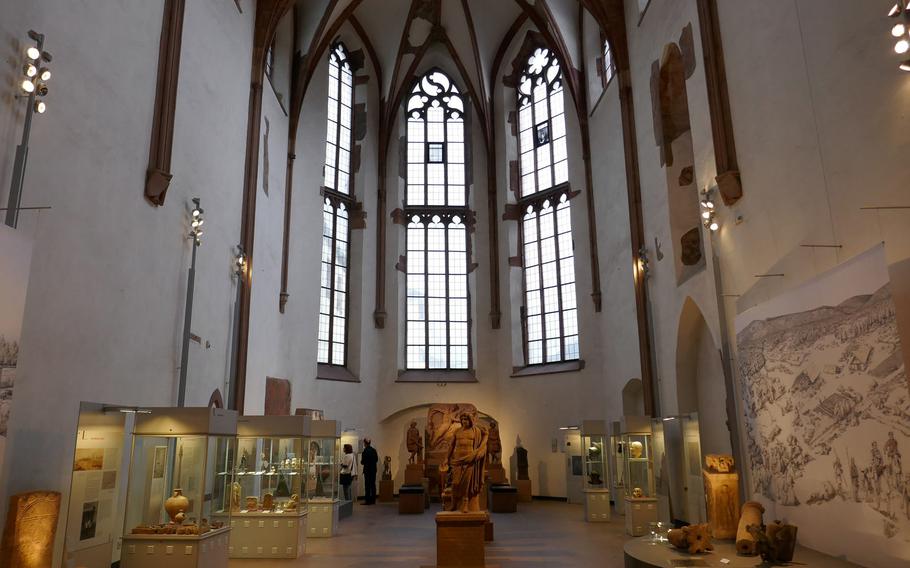
The Roman collection of the Archaeological Museum is housed in the old church of the former Carmelite monastery in Frankfurt, Germany. (Michael Abrams/Stars and Stripes)
Frankfurt is a city of many museums. A stretch of the Main River embankment is even named after the row of museums there.
But there are others scattered through town and one of them, tucked away in a former Carmelite monastery, is full of ancient treasures.
The Archaeology Museum started as a department of the city’s Historical Museum in the late 19th century. The department moved a couple of times as it grew and finally became a museum of its own. Located in the monastery and its newer extensions since 1969, it has been officially called the Archaeologisches Museum since 2002.
Its collections span many millennia, from prehistory to the Early Middle Ages.
The prehistory section has artifacts from the Stone Age through the Iron Age; the oldest item on display is a flint hand ax. Most of the objects here were discovered in finds from Neolithic settlements around Frankfurt. The grave of an early Celtic chieftain is a collection highlight.
Indeed, many of the things on display here were found in Frankfurt and its surroundings.
The ancient Orient collection is an exception. That collection is quite extensive, with a floor of its own in a wing of the museum. On display are finds mostly from Iran, Syria and Anatolia. They include weapons, exquisite gold jewelry and ceramics, including a lamp or bowl shaped like a bat.
The floor below houses the classical antiquity section. Here artifacts from the Greek, Mycenaean and Etruscan cultures are on display. The collection shows how far-flung trade in Europe was, even 2,500 years ago, with most of these Mediterranean artifacts found in the Frankfurt area.
That the Romans were once in the area is well-known. The reconstructed Saalburg, a Roman fort, stands in the nearby Taunus mountains, and the remnants of Nida, a Roman town, have been excavated in neighboring Heddernheim.
So it’s no surprise that the Roman section makes up the museum’s largest collection. Housed in the former monastery’s church, it features tall, graceful columns honoring the Roman god Jupiter, an altar dedicated to the cult of Mithras and helmets, armor and weapons.
The museum’s final section is dedicated to the Alemannia and the Franks. Most of the artifacts here are from a series of graves found near Frankfurt-Harheim. Those graves contained jewelry, weapons and food and gifts for the dead.
Among the most intriguing finds was the grave of a Frankish girl, buried under the Frankfurt Cathedral. Undoubtedly the child of someone of importance, she was buried with vessels, golden rings, golden bracelets, a necklace and a small ornate container.
The museum also hosts temporary exhibits, and until Feb. 4, visitors can see the fascinating show “Gods of the Etruscans.” It features items from the museum’s own collections but relies heavily on pieces from the Museo Archeologico Nazionale in Florence and the Museo Etrusco Guarnacci in Volterra, Italy.
The Archaeologisches Museum Frankfurt DIRECTIONS
The Archaeologisches Museum Frankfurt is at Karmelitergasse 1, 60311 Frankfurt am Main. In downtown Frankfurt, the nearest parking garages are Dom and Hauptwache. The closest public transportation stop is Willy-Brandt-Platz, where subway lines U1 to U5 and U8 and tram lines 11 and 12 stop.
TIMES
10 a.m. to 6 p.m. Tuesdays-Sundays; 10 a.m. to 8 p.m. Wednesdays. Closed Mondays and Dec. 24, 25 and 31.
COSTS
Admission is 7 euros for adults; children under 18 enter for free. The museum is free for all on the last Saturday of the month. Expect to pay about 2 euros per hour for parking.
FOOD
There are beverage and vending machines in the museum’s small cafe, but restaurants of all types are nearby.
INFORMATION
Website: www.archaeologisches- museum.frankfurt.de. Click on the British flag for the English-language version.